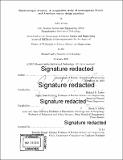Epistemologies of safety : a comparative study of contemporary French and American reactor design practices
Author(s)
Verma, Aditi.
Download1103608360-MIT.pdf (18.71Mb)
Alternative title
Comparative study of contemporary French and American reactor design practices
Other Contributors
Massachusetts Institute of Technology. Department of Nuclear Science and Engineering.
Advisor
Richard K. Lester.
Terms of use
Metadata
Show full item recordAbstract
What makes for a safe nuclear power reactor? One of school of thought (that has significant traction within the academic nuclear engineering community) calls for using risk as a surrogate for safety. Safety then becomes a measurable quantity and can be specified in probabilistic terms and treated quantitatively. But do reactor designers in fact conceptualize safety in this way? I probe this question empirically through a comparative study of contemporary French and American reactor design practices. I examine the evolution of national nuclear safety regulators' conceptualizations of safety, industry norms, pedagogical context, the manner in which reactor designers make foundational early-stage design decisions, their use of formal models of risk and local heuristics, and finally their response to crisis (in this case the Fukushima Daiichi accident). I find that designers broadly take two different approaches to the early stages of design. Some designers draw on and emulate aspects of previous designs on which they have worked and which have been developed within their companies. For these designers, improvements in safety, measured in quantitative terms as risk reductions, take the form of improvements to prior designs. Another set of designers, while also drawing on previous reactor designs, typically adopt a critical stance towards these designs. They frame the improvements in safety they hope to achieve in qualitative terms, and explore a wider range of design choices within what we might consider a wider design space. Taken together these findings suggest that the reactor designers' conceptualizations of safety are deeply nuanced. To the reactor designer, safety is not always conceptualized as risk and is often framed qualitatively rather than quantitatively. It is a property that is contingent on the designer's background and the design setting. Further, the designers' own accounts of their work suggest that it is precisely these qualitative ways of thinking about the design problem that led them toward novel design ideas, and ultimately to achieving advances in safety. This suggests that designers should learn how to further draw on these non-analytical ways of thinking about safety. For the academic nuclear engineering community, these findings underscore the importance of the early, ideational stages of design. Further study and conceptualization of these early stages of design may be a fruitful area of inquiry for improving design outcomes. Finally, the varied and diverse accounts of safety held by the reactor designers studied in this work bear some similarities to the views of non-experts reported in the literature on risk perceptions. Thus, for the design practitioner, these findings suggest the possibility of a richer dialog with the public on nuclear safety, going beyond the traditional emphasis on public education and securing public acceptance.
Description
Thesis: Ph. D., Massachusetts Institute of Technology, Department of Nuclear Science and Engineering, 2019 Cataloged from PDF version of thesis. Includes bibliographical references (pages 191-213).
Date issued
2019Department
Massachusetts Institute of Technology. Department of Nuclear Science and EngineeringPublisher
Massachusetts Institute of Technology
Keywords
Nuclear Science and Engineering.